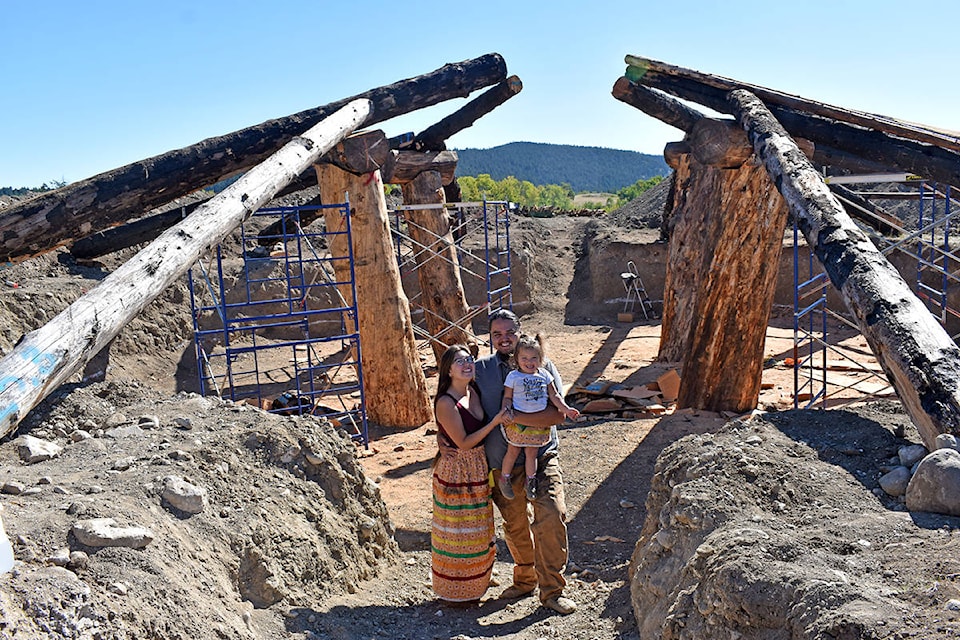Peyal Laceese has no qualms about building a traditional pit house for his new family home.
“Growing up I always heard of our people living in pit houses, and it’s always been in the back of my mind that’s how I want to live,” Laceese said at the site near Tl’esqox (Toosey) 40 kilometers west of Williams Lake.
“I’m excited to raise my daughter in a pit house like this as I can’t even imagine how special I would have felt if I grew up in a pit house.”
Late Wednesday morning Laceese’s partner Loretta Jeff Combs showed Black Press Media how to hand peel the wildfire burnt outer bark from one of hundreds of logs that will be used as poles to form the roof of the pit house which will be eventually covered with two to three feet of earth where a garden will grow.
As the outer layers of bark fell to the ground while Loretta used a debarking tool, their two-year old daughter Nildziyenhiyah played in the earthen soil that had been removed to make a 12-foot deep and 60-foot diameter hole for the pit house.
Read More: Indigenous perspective continues to be shared at B.C. Gold Rush historic town and park
Nildziyenhiyah—meaning wind walker—was born just 20 minutes after Loretta arrived at Cariboo Memorial Hospital in Williams Lake on Aug. 4, 2018 in labour.
Following her birth, the family has since resided in Williams Lake.
With full support from Loretta, Laceese said it was not until earlier this year after he was part of a Tsilhqot’in Nation delegation to New Zealand that he decided to act on his vision to build the pit house.
“When we were there the Māori hosted us in their traditional homes,” he said, noting the Tsilhqot’in Nation’s small pit houses at Nemiah Valley are not nearly large enough to house or host anyone.
“Once I experienced that it kind of solidified the idea in my mind that we have to do the same thing, and we have to have the same type of opportunity to do the same for not only when the Māori come back up but any other nations that come into the territory.”
Before earth was removed and logs were lifted and set to form the structure by local machine operator Len McClure, Laceese developed blueprints and drawings with his brother Kiko who resides in a pit house at Mount Currie.
Read More: Tsilhqot’in utilize social media after annual Nation Gathering called off due to COVID-19
The breathtaking structure consists of 12 main beams circling a full 360 degrees, supported by four old growth Douglas Fir logs that are at least 600 years old and were donated from Toosey Old School Wood Products.
“A long time ago we had a lot of manpower,” Laceese said, adding he believes it would have taken at least 100 people to dig out the earth of a historic pit house approximately 20 feet away.
“Usually it was always the women that dug out the hole while the men went out and collected the logs and lifted the logs as well,” he said.
Although the integration of modern technology saved Laceese and his family from a laborious undertaking, as per the stories passed down by elders, Laceese and male family members went and collected logs earlier this week while the women stayed at the site and peeled logs.
When the outer structure is finished before snowfall, work on the adobe flooring which will be made from a mixture of mud, clay, pine needles and sand will commence.
The only non-natural elements will be nails as well as a pond liner that will be put on top of the pit house as an additional precautionary tool to keep moisture out.
Through the Earth’s geothermal energy, the pit house will be very warm in the winter and very cool in the summer. A wood stove will be used when the winters prove to be too harsh.
Laceese said the pit house will be the largest currently standing in all of North America.
He hopes to be able to not only utilize it as a family living space, but also as a space to hold community events and host guests.
“This is definitely not going to be the last pit house,” he said, noting a possible museum for Tsilhqot’in artifacts currently housed at UBC’s Museum of Anthropology in Vancouver.
“Chief Joe Alphonse is already hinting about making one [a pit house] for Tl’etinqox (Anaham),” he added. “Knowing Chief Joe he’s going to want to go bigger after seeing this.”
Do you have a comment about this story? email:
rebecca.dyok@wltribune.com
Like us on Facebook and follow us on Twitter.
